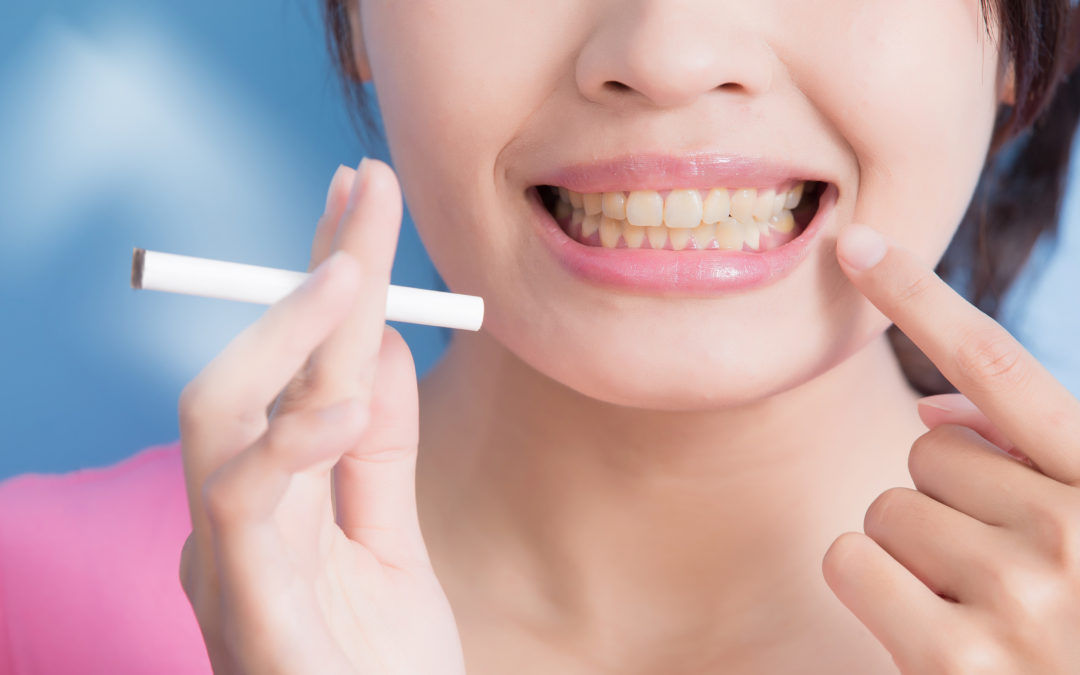Tobacco has many ill effects on the health of an individual. Dental health is equally affected with use of tobacco. From dark stains to poor gum health to increased incidence of decay to the more severe effects like oral cancer, tobacco has a very detrimental effect on your dental health. Read on know more about how harmful tobacco can be on the dental system.
Brown teeth and tongue: One of the tell-tale signs of a smoker are the brown teeth and stained tongue and lips. A dentist need not even be told that the person smokes, it just shows!! What is interesting is that these stains on the teeth do not easily go away with a scaling (Cleaning of teeth), they just continue to form as long as tobacco is being put into the system.
Gum disease: The oral health of a smoker is definitely not at its best. With the stains on the teeth, the gums are more prone for irritation and infection. This leads to grayish, unhealthy gums. The periodontal fibers are also affected, leading to bad breath, pocket formation and even tooth mobility in severe cases. The mouth is generally drier in comparison and so bacterial growth is more favored, further accelerating the process of gum disease and teeth decay.
Dental caries: The increased amount of bacteria and dryness in the mouth leads to greater incidence of dental decay. Chances of cervical decay (decay around the gum line) and root decay are higher in smokers.
Bad breath: Use of tobacco in itself cause bad breath which is exacerbated by dry mouth caused by useof tobacco.
Impaired taste: The tongue has a constant coating too, leaving the taste buds unable to completely taste food substances. Ask any smoker a couple of questions and you would realize how they never get to enjoy and taste the food as it should be.
Poor healing: Whether it is a gum disease, a tooth removal or a root canal therapy, smokers who go for dental treatment need a longer time to respond compared to nonsmokers. If smoking is continued at the same pace, then the chances of developing a dry socket with an extraction or a failed root canal therapy are quite high. There are more failures reported in success of implant in smokers as compared to non smokers.
Cancer: The most dangerous and the most severe of all, cancer of the cheek, gums, lips, tongue, roof of the mouth can all happen in smokers, twice more likely in comparison with non-smokers.
Now, if all these are not good enough to kick the habit, remember this list is only for the mouth and the teeth. The whole body goes through a lot more harmful effects, and that should be a good reason to quit tobacco use in any form. If you need professional help, do not be embarrassed to seek.

Health experts have highlighted this fact several times before that smoking during pregnancy can lead to serious health issues for the growing baby inside. Nicotine is a potent chemical with the capability of causing havoc for kids and adults alike. The phase of pregnancy is an important phase, where several factors must be kept in mind in order to secure the life of the mother and growing baby. As much difficult as it may be to give up smoking, since nicotine is highly addictive, there is no other way to ensure that your child doesn't face any health problems in the future. Even passive smoking is found to be harmful for health, so one can only imagine how hazardous direct smoking could be. Research studies have found that the repercussions of smoking during pregnancy are such that it could even alter the baby's DNA, leading to abnormalities. A recent study states that nicotine exposure before and after birth may put babies at an increased risk of developing hearing problems due to abnormal development in the auditory brainstem.
The study done by Free University of Berlin in Germany showed that when pregnant mothers are exposed to nicotine, it could lead to abnormal development in kids, such as hampering the auditory brainstem - an area of the brain which plays a role in analysing sound patterns. Children with impaired auditory brainstem function are likely to have learning difficulties and problems with language development.
"If mothers smoke during pregnancy and their children show learning difficulties at school, they should be tested for auditory processing deficits," said lead author Ursula Koch, professor at the Free University of Berlin.
For the study, published in The Journal of Physiology, the team exposed the offspring of the mice to nicotine before birth and via the mother's milk until they were three weeks old - an age that is approximately equivalent to primary school children.
Analysing the brains of the mice offsprings, the researchers found that neurons that get input from the cochlea - sensory organ in the ear - were less effective at transmitting signals to other auditory brainstem neurons in mice exposed to nicotine. Moreover, these signals were transmitted with less precision, which deteriorates the coding of sound patterns. These could be part of the underlying causes for auditory processing difficulties in children of heavy smoking mothers, the researchers said.
"We do not know how many other parts of the auditory system are affected by nicotine exposure. More research is needed about the cumulative effect of nicotine exposure and the molecular mechanisms of how nicotine influences the development of neurons in the auditory brainstem," Koch said.
In developing countries around the world especially in Asia, secondhand smoke causes thousands of stillbirths every year. Exposure to secondhand smoke during pregnancy increases the risk of stillbirth, congenital malformations, low birth-weight and respiratory illnesses.
In a recent study, researchers found that 40% of all pregnant women in Pakistan are exposed to secondhand smoke - causing approximately 17,000 stillbirths in a year.
The team from the University of York looked at the number of pregnancies alongside smoking exposure data in 30 developing countries from 2008 to 2013. The analysis revealed that in Armenia, Indonesia, Jordan, Bangladesh and Nepal more than 50% of pregnant women reported exposure to household secondhand smoke.
In Indonesia alone, 10,000 stillbirths take place every year. In Pakistan, only 1% of stillbirths are attributed to women actively smoking during pregnancy, but for secondhand smoke, the figure is 7%, largely due to the high numbers of pregnant women exposed to tobacco smoke in the home.
In five of the 30 countries, household secondhand smoke exposure was twice as common as active smoking."This is the first study which provides national estimates for 30 developing countries on secondhand smoke exposure in pregnancy and it reveals a huge problem, a problem which is not being addressed," said a lead researcher Kamran Siddiqi.
"We have shown for the first time that secondhand smoke during pregnancy is far more common than active smoking in developing countries, accounting for more stillbirths than active smoking.
Protecting pregnant women from secondhand smoke exposure should be a key strategy to improve maternal and child health," he added.
They also say further work is needed to develop effective interventions to reduce household exposure to secondhand smoke. The study appeared in the BMJ Tobacco Control Journal.
Exercise doesn’t just keep you healthy and fit. Turns out, it can also help people fight addiction. A study conducted by the University of Buffalo has identified a key mechanism on how aerobic exercise can help impact the brain in ways that may support treatment and prevention strategies for addiction.
Aerobic exercises are a form of cardio exercise that increase the heart rate, breathing and circulation of oxygen through the blood. It can also help people who are suffering from diabetes, heart disease and arthritis. It also offers mental health benefits, such as reducing stress, anxiety and depression.
“Several studies have shown that, in addition to these benefits, aerobic exercise has been effective in preventing the start, increase and relapse of substance use, including alcohol, nicotine, stimulants and opioids,” said Panayotis (Peter) Thanos, the senior author of the study.
Using animal models, Thanos and his team found that daily aerobic exercise altered the mesolimbic dopamine pathway in the brain. Dopamine is a neurotransmitter associated with substance use disorders, and plays an important role in reward, motivation and learning.
The study is published in the journal Medicine & Science in Sports & Exercise.
Other interesting ways to kick addictions
* Nose spray that helps you kick gambling habit
In January, Finnish researchers said they were to launch a study to see if gambling addiction can be treated with a fast-working nasal spray. The spray contains naloxone, an emergency treatment for opiate overdoses (heroin, opium, morphine) that blocks the production of dopamine, a neurotransmitter linked to pleasure with a central role in addictions.
* Facebook to quit smoking
A clinical trial done by the University of California-San Francisco (UCSF) shows that smokers were 2.5 times more likely to quit post a cessation intervention programme delivered entirely on social networking giant Facebook than by other online quit-smoking programmes.
* Cut down on sugar to overcome alcohol addiction
It is believed that alcohol has a direct connection with sugar. So, if you want to avoid craving for liquor, cut down on your sweet intake.
सध्याच्या काळात महिलांमध्येही धूम्रपान आणि मद्यपानाचे प्रमाण वाढलेले दिसते. स्त्रियांच्या आरोग्यावर, विशेषत: जननक्षमतेवर त्याचे काय परिणाम होतात, ते जाणून घ्यायला हवे.
भारतात सरासरी २०.३ टक्के महिला धूम्रपान किंवा अन्य प्रकारे तंबाखूचा वापर करताना दिसतात. त्यातील ९० टक्के स्त्रिया धूरविरहित तंबाखूचा वापर करताना दिसतात. धूम्रपान अथवा तंबाखू सेवानास सुरुवात होण्याचे सरासरी वय १७.८ वर्षे आहे. २५ टक्के महिला १५ वर्षांखालील आहेत. ग्लोबल अॅडल्ट टोबॅको सर्व्हे (२०१६) यानुसार ही आकडेवारी आहे.
सिगारेट, विडी, तंबाखू, गुटखा, जर्दा, खैनी, मिश्री, मावा हे सर्व तंबाखूयुक्त पदार्थ आहेत. तंबाखूमध्ये ४००० प्रकारची रसायने आढळतात. त्यावर पुढे प्रक्रिया केल्यास (जाळणे, भाजणे, दळणे, वाटणे, मळणे) त्यातून ७००० रसायने निर्माण होतात. ती घातक ठरू शकतात.
तंबाखूमध्ये निकोटीन नावाचे रसायन आहे. त्याचे घटक शरीरातील चेतातंतूंच्या टोकाला तयार होणारे रसायन उत्तेजीत करतात. त्यातील एक रसायन सेवन करणाऱ्याला जागृत आणि उत्तेजीत करते. डोपामाइन नावाचे रसायन सेवनकर्त्याला व्यसनाधीन करण्यास कारणीभूत आहे. हेरॉइन नावाच्या नशिल्या पदार्थापेक्षा हा निकोटीत जास्त प्रमाणात व्यसनाधीनता वाढवतो, याचे शास्त्रीय पुरावे आहेत.
स्त्रियांमध्ये धूम्रपानास सुरुवात झाल्याचा इतिहास विलक्षण आहे. १९२०साली अमेरिकेमध्ये स्त्रियांमधील धूम्रपान करणे चुकीचे मानले जाई. सिगारेटच्या जाहिरातीत मॉडेल म्हणून त्या आल्या आणि स्त्रियांमधील धूम्रपानास सुरुवात झाली. भारतामध्ये स्त्रियांमधील धूम्रपानाचा इतिहास नोंदलेला नाही; परंतु तंबाखूच्या वापरामुळे गर्भपिशवीच्या ग्रिव्हेचा कर्करोग होतो, हे टाटा कॅन्सर रिसर्च सेंटरच्या संशोधनातून सिद्ध झाले आहे.
स्वत:च धूम्रपान करणे तसेच बरोबर असलेल्या व्यक्तीचे धूम्रपानही घातक आहे. धूम्रपान झालेल्या जागेमध्ये (भिंती, कार्पेट, पडदे) रसायनाचा थर साचतो. त्यातील अर्क श्वसनातून, त्वचेतून शरीरात जाऊन नुकसान होऊ शकते,
स्त्रियांसाठी माइल्ट अथवा मेंथॉल किंवा फिल्टरच्या सिगारेट मिळतात. त्या सुरक्षित असतात, या जाहिरातबाजीत काही अर्थ नाही. कोणतेही निकोटिन आणि तंबाखूयुक्त पदार्थ सुरक्षित नाहीत.
धूम्रपानामुळे पुरुषांमध्ये कमी क्षमतेचे वीर्यधातू निर्माण होतात. त्यांची विहार क्षमता बिघडते. याबरोबर गर्भपिशवीला चिकटण्याची गर्भाची क्षमता खालावते व गर्भ रुजत नाही. त्यातून वंध्यत्व येऊ शकते.
गर्भपात, गर्भामध्ये व्यंग असणे, गर्भाची वाढ खुंटणे, मुदतपूर्व प्रसुती, वार सरकून होणारा रक्तस्राव, कामाची क्षमता कमी होणे, रक्तदाब असे अनेक दुष्परिणाम होतात.












